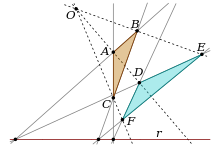ဂေသြမေတြဳ

ဂေသြမေတြဳ (အၚ်္ဂလိက်: Geometry) (နူ ဂရိတ်တြေံ: γεωμετρία; geo- "တိ", -metron "ဗ္ၜတ်") ဂှ် ဒှ်လစှ်ေ ကွတ်သင်္ချာ တြေံအိုတ်မွဲရ။ ဂေသြမေတြဳဂှ် ဒှ်ကွတ်တၟော် သွက်ဂွံတီ ဇမၞော်၊ သမၠဲ၊ ဇမ္ၚောဲ၊ သဏ္ဌာန်၊ ကေုာံ ဒတန်ဒမံင် ဗီုရုပ်တအ်ရ။[၁] အစာဂၞန် မကၠောန်ကမၠောန် ပ္ဍဲကဵု ဘာသာဏအ်ဂှ် ညးကော်စ ဂေသြမေတာ (geometer) (ဝါ) သၟာဂေသြမေတြဳ။
စဵုကဵု ၁၉ ဗွဝ်ကၠံ၊ အရာမတော် မပ္တံကဵု ကၞောတ် (point)၊ (line) (plane) (distance) (angle) (surface) ကေုာံ (curve) တအ်ဂှ် ဟွံပၠုပ်အဝေါင် အပ္ဍဲကဵု ဂေသြမေတြဳဏီရ။ အရာတအ်ဂှ် နကဵု တၠပညာယူကလိဒ် ပၠုပ်စုတ်တုဲ ကလိဂွံအာ ယၟု ယူကလိဒ်ဂေသြမေတြဳ (Euclidean geometry) ရ။[၂]
ပ္ဍဲအခိင်ကာလ ၁၉ ဗွဝ်ကၠံဂှ် သဏ္ဌာန်ဂၞန် ဗွဲမဂၠိုင် တၠပညာတအ် ကၠာဲဆဵုကေတ်တုဲ စုတ်ပၠုပ် အပ္ဍဲကဵု ဂေသြမေတြဳ တုဲ ပညာဂေသြမေတြဳလေဝ် လှဲလးအာဗွဲမလောန်ကီုရ။ ပၞောဝ်ကဵု တေသြရဳ တၠပညာတအ် မဂွံဆဵုကေတ်ဂမၠိုင်ဂှ် တၠပညာဂကူဂျာမာန် ကာရ်ဖြိဒြိချ် ဂုသ် (Carl Friedrich Gauss) မဂွံဆဵုကေတ်လဝ် မကော်ဂး Gauss' Theorema Egregium မဒှ်တေသြရဳ မတော်ဇမၞော်ဗလးဂမၠိုင်ဂှ် ဒှ်တေသြရဳ တၟေင်မွဲရ။
လညာတ်အဓိက ပ္ဍဲ ဂေသြမေတြဳ
[ပလေဝ်ဒါန် | ပလေဝ်ဒါန် တမ်ကၞက်]သၟဝ်ဏအ်ဂှ် ဗၟံက်ထ္ၜးကဵု လညာတ်အဓိက လ္ၚဵု ပ္ဍဲ ကဵုဂေသြမေတြဳ။[၂][၃]
အက်ဇြိသောမ် (Axiom)
[ပလေဝ်ဒါန် | ပလေဝ်ဒါန် တမ်ကၞက်]
အက်ဇြိသောမ် (axiom)၊ ပေါသတုလိက် (postulate)၊ ဟွံသေင်မ္ဂး အဿုမ်ရှေန် (assumption) တအ်ဂှ် ဒှ်ဝေါဟာရသင်္ချာ ဒဒှ်ရ မဗၟံက်ထ္ၜး ဒှ်အရာမဍာံစၟတ်ရ။[၄][၅] အက်ဇြိသောမ်ဂှ် ကၠုင်နူ အရေဝ်ဂရိတ် ἀξίωμα (axíōma) မဂွံအဓိပ္ပါယ် သက်သဳ သာဓက၊ ဇၟာပ်အရာပိုယ်မဟီုဂှ် ဒှ်ဂလာန်မဍာံစၟတ်ဂှ် ထ္ၜးသက်သဳ သာဓက ရ။[၆]
နဲကဲ ယူကလိဒ် (Euclid) မစကာ ဂေသြမေတြဳဂှ် ဒှ်နဲကဲ မချပ်ဗစာ မနွံကဵုသက်သဳသာဓကတုဲ [၇]လိက်ညးဂှ် ဒှ်လိက်ကိစ္စဇၞော်တုဲ စကာဂၠိုင်အိုတ် ၜိုတ်လိက်မကေင်ချူလဝ်တအ်ဂှ်ရ။[၈] ယူကလိဒ် ညးဗၟံက်ထ္ၜးကဵု အက်ဇြိယောမ်ဂမၠိုင်၊ ပေါသတုလိဂမၠိုင် (postulates)၊ လဟီုအဓိက (expressing primary)၊ သက်သဳ-အလဵုဇကု မဆေင်ကဵု ဒြပ် ဒဒက်တဴ ကုဍံက်ဂမၠိုင် (point)၊ ပၞောန် (line)၊ ကေုာံ ဗလးဂမၠိုင် (plane)ရ။[၉] နဲကဲညးဂှ် ပသောင်ကလးကဵု သွဟ်ဂၞန်တၞဟ်တၟာဂလိုင်ရ။ နဲကဲတော် ဂေသြမေတြဳ ယူကလိဒ်ဂှ် ဇြိုဟ်နက်၊ ဝါတ်ဂါတ်တုဲ ညးကော်စ အက်ဇြိသောမ်တိစ် ဟွံသေင်မ္ဂး သုန်ထေတိစ် ဂေသြမေတြဳ (axiomatic or synthetic geometry)။[၁၀]
ဍံက်ဂမၠိုင် (Points)
[ပလေဝ်ဒါန် | ပလေဝ်ဒါန် တမ်ကၞက်]ဍံက် ဟီုမ္ဂးဂှ် လတူဗလးမွဲဂှ် ဒၞာဲမဍံက်စၟတ်သမ္တီလဝ်ဂှ် ညးကော်စ ဍံက်ရ။ ပ္ဍဲကဵု ယူကလိဒ်ဂေသြမေတြဳမ္ဂး ဍံက်ဂှ် ဒှ်အရာတမ်မူလရ။ ပွံက်အဓိပ္ပါယ် ဍံက်ဂှ် ပံက်လဝ် နွံနာနာသာ် အလဵုဇကု ယူကလိဒ်ဂှ် ပံက်လဝ် 'မဒှ်အရာ မဟွံမဲ ကုလစှ်ေ (that which has no part)'[၁၁] တုဲ အလုံမွဲမစကာ အလ်ဂေဗြာ (algebra)။[၁၂] ပ္ဍဲကဵု ဨရိယာ ဂေသြမေတြဳ မပ္တံကဵု (analytic geometry)၊ (differential geometry)၊ ကေုာံ topology၊ အရာအိုတ်သီုဂှ် စၟတ်သမ္တီလဝ် ဒဒှ်ရ မဒက်ပ္တန်လဝ် နူကဵု ဍံက်ဂမၠိုင်ရ။ ဆဂး ဂေသြမေတြဳလ္ၚဵုဂှ် ဟွံစ နကဵု ဍံက်လေဝ် နွံကီုရ။[၁၃]
ပၞောန်ဂမၠိုင် (Lines)
[ပလေဝ်ဒါန် | ပလေဝ်ဒါန် တမ်ကၞက်]ယူကလိဒ် ဗၟံက်ထ္ၜးလဝ် ပၞောန်မွဲဂှ် ဒှ် "ဇမၠိင် မသက်ကုကၞောတ်" မဒှ် အရာ "မနွံဒၟံင် ဗွဲမတုပ်သၟဟ် အပိုင်အခြာ အပ္ဍဲ ဍံက်ဂမၠိုင်ရ။"[၁၁] ပ္ဍဲကဵု သင်္ချာခေတ်တၟိဂမၠိုင်မ္ဂး လညာတ်သမ္တီ ပၞောန်မွဲဂှ် မတုပ်ကဵု အပိုင်အခြာ မဗၟံက်ထ္ၜးလဝ် ဂေသြမေတြဳရ။ ဥပမာ ပ္ဍဲကဵု In modern mathematics, given the multitude of geometries, the concept of a line is closely tied to the way the geometry is described. For instance, in analytic geometry, a line in the plane is often defined as the set of points whose coordinates satisfy a given linear equation,[၁၄] but in a more abstract setting, such as incidence geometry, a line may be an independent object, distinct from the set of points which lie on it. In differential geometry, a geodesic is a generalization of the notion of a line to curved spaces.[၁၅]
ဗလးဂမၠိုင် (Planes)
[ပလေဝ်ဒါန် | ပလေဝ်ဒါန် တမ်ကၞက်]ဗလး ဟီုဂှ် ဒှ်ဒၞာဲ၊ ဗၞတ်ဗ္ၜတ်ပမာဏ (ဨရိယာ)။[၁၁] ဗလးဂှ် စကာ ပ္ဍဲကဵုကာလမတော် ဨရိယာ ဂေသြမေတြဳ။ ဥပမာ ဗလးဂှ် တော်လ္ၚတ် ဇမၞော်ဗလးမုက်မွဲမွဲတအ်ဒှ်တမ်ရ။
ဒကဴဂမၠိုင် (Angles)
[ပလေဝ်ဒါန် | ပလေဝ်ဒါန် တမ်ကၞက်]Euclid defines a plane angle as the inclination to each other, in a plane, of two lines which meet each other, and do not lie straight with respect to each other.[၁၁] In modern terms, an angle is the figure formed by two rays, called the sides of the angle, sharing a common endpoint, called the vertex of the angle.

သဏ္ဌာန် ဂေသြမေတြဳဂမၠိုင်
[ပလေဝ်ဒါန် | ပလေဝ်ဒါန် တမ်ကၞက်]- ဝိုင်စက် (Circle) - မဒှ် သဏ္ဌာန် မဂေတ် နကဵု နူကဵု ဍံက်လဒေါဝ် မနွံကဵု raius တုပ်ပ်။ ဥပမာ - သၠာကွဳ။
- စတုဂံ (ပန်ကၠင်) (Square) - မဒှ် သဏ္ဌာန် မနွံကဵု ပန်ကရေက် ဇမၠိင်တုပ်တုဲ နွံကဵု ဒကဴမတုပ်။ e.g., a garage, square rubber stamps, tiles on the floor
- တြိဂံ (ပိကၠင်) (Triangle) - မဒှ် သဏ္ဌာန် မနွံကဵု ပိကရေက်တပ်ပ်။ e.g., a slice of pizza, a slice of cheese cut in that shape, a sandwich cut diagonally
Rectangle: Four straight sides with four right angles, different length and width e.g., apartment buildings, hopscotch board, a book cover, most cell phones
Pentagon: Five straight sides, typically of equal length e.g., The Pentagon, the designs found on soccer balls
Hexagon: Six straight sides, typically of equal length e.g., ice crystals, some snowflakes, beehive cells
Heptagon: Seven straight sides, typically of equal length e.g., covers for a cookie bin, some types of pill boxes
Octagon: Eight straight sides, typically of equal length e.g., stop sign, some umbrellas, UFC ring
Nonagon: Nine straight sides, typically of equal length e.g., lids for some types of cookie bins/containers
Decagon: 10 straight sides, typically of equal length e.g., certain collectors coins
Trapezoid: Four-sided figure with just one pair of parallel sides e.g., the trusses on some bridges, a pyramid with the top cut off, a popcorn box
Parallelogram: Four-sided figure with two pairs of parallel sides e.g., a classic eraser, some purses, the structure of some bridges
Rhombus: A parallelogram with equal length sides e.g., baseball diamonds, some kites, certain crystals
Star: A multi-sided polygon with points and obtuse angles e.g., Star of David, star stickers, star necklace, star cookie cutters
Crescent: A curved sickle shape, curved and tapers to a point e.g., crescent rolls, the moon during certain phases, the curved shape on the flags of Pakistan and Turkey
Oval: A stretched out circle where the radius is shorter on one axis than the other e.g., eggs, buns for a hot dog, a running track
Semicircle: A circle cut exactly in half along its diameter e.g., half a cookie, half a pizza pie, other incomplete circles
Cylinder: A three-dimensional figure with parallel sides and a circular cross-section e.g., cardboard inside a paper towel, a straight pipe, a drinking glass
Prism: A three-dimensional figure where one pair of opposite sides are the same shape, connected by straight, parallel sides e.g., cardboard box, cameras, cereal box, Toblerone box
Pyramid: A three-dimensional figure with one flat side and edges emerging to come together at a point e.g., the Great Pyramid of Giza, roof of a house
နိဿဲ
[ပလေဝ်ဒါန် | ပလေဝ်ဒါန် တမ်ကၞက်]- ↑ Vincenzo De Risi (31 January 2015). Mathematizing Space: The Objects of Geometry from Antiquity to the Early Modern Age. Birkhäuser, 1–. ISBN 978-3-319-12102-4။
- ↑ ၂.၀ ၂.၁ Tabak, John (2014). Geometry: the language of space and form. Infobase Publishing, xiv. ISBN 978-0816049530။
- ↑ Morris Kline (March 1990). Mathematical Thought From Ancient to Modern Times: Volume 3. Oxford University Press, USA. ISBN 978-0-19-506137-6။
- ↑ Cf. axiom, n., etymology. Oxford English Dictionary, accessed 2012-04-28.
- ↑ Oxford American College Dictionary: "n. a statement or proposition that is regarded as being established, accepted, or self-evidently true. ORIGIN: late 15th cent.: ultimately from Greek axiōma 'what is thought fitting,' from axios 'worthy.' HighBeam[dead link]ထာမ်ပလိက်:Cbignore ထာမ်ပလိက်:Subscription
- ↑ Axiom — Powszechna Encyklopedia Filozofii.
- ↑ Victor J. Katz (21 September 2000). Using History to Teach Mathematics: An International Perspective. Cambridge University Press. ISBN 978-0-88385-163-0။
- ↑ David Berlinski (8 April 2014). The King of Infinite Space: Euclid and His Elements. Basic Books. ISBN 978-0-465-03863-3။
- ↑ Robin Hartshorne (11 November 2013). Geometry: Euclid and Beyond. Springer Science & Business Media. ISBN 978-0-387-22676-7။
- ↑ Pat Herbst (16 March 2017). The Learning and Teaching of Geometry in Secondary Schools: A Modeling Perspective. Taylor & Francis. ISBN 978-1-351-97353-3။
- ↑ ၁၁.၀ ၁၁.၁ ၁၁.၂ ၁၁.၃ Euclid's Elements – All thirteen books in one volume, Based on Heath's translation, Green Lion Press ISBN 1-888009-18-7.
- ↑ Clark. "Individuals and Points": 61–75.
- ↑ Gerla, G. (1995). "Pointless Geometries", in Buekenhout, F.: Handbook of incidence geometry: buildings and foundations. North-Holland, 1015–1031။
- ↑ Analytic Geometry of the Point, Line, Circle, and Conic Sections။
- ↑ geodesic – definition of geodesic in English from the Oxford dictionary. OxfordDictionaries.com. Archived from the original on 2016-07-15။ Retrieved on 2020-11-17။
